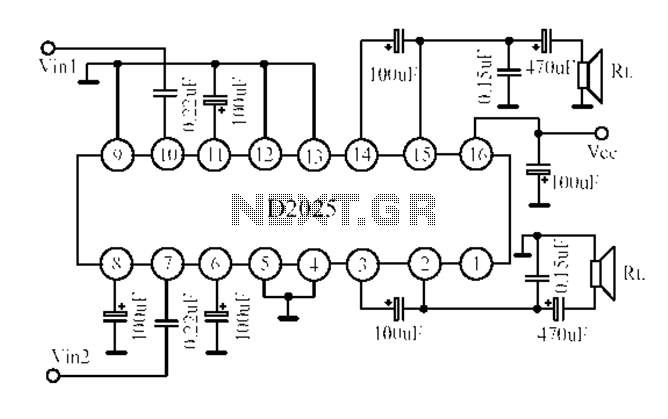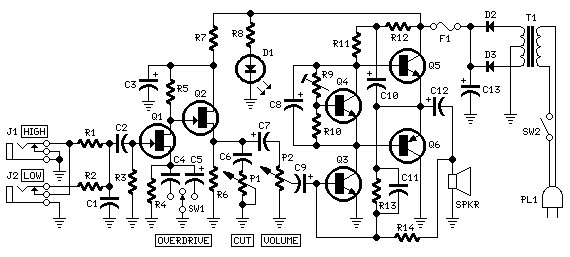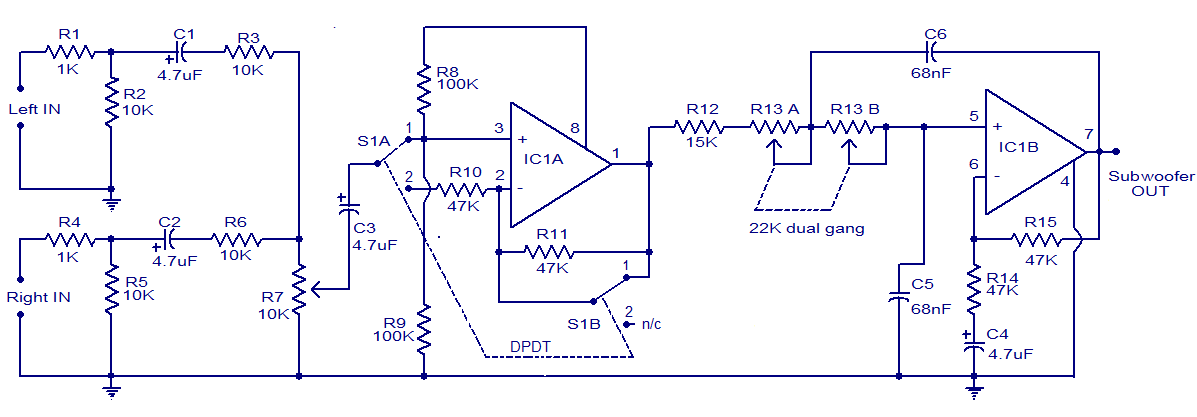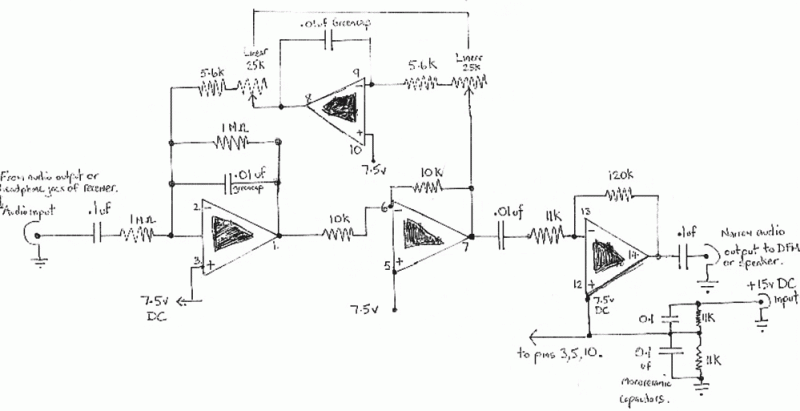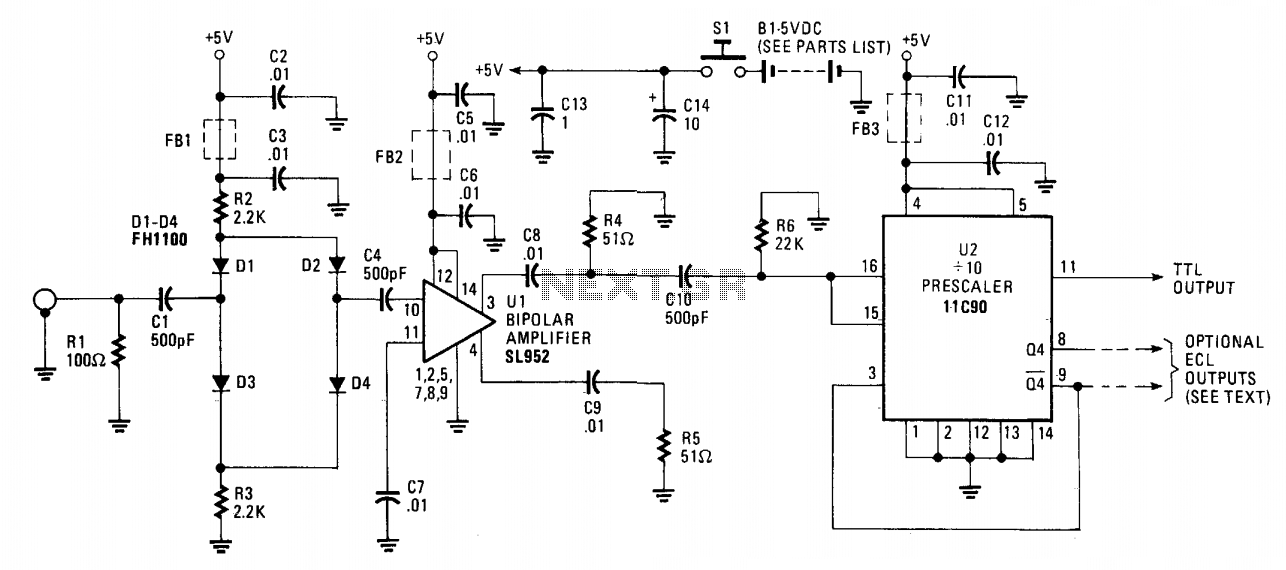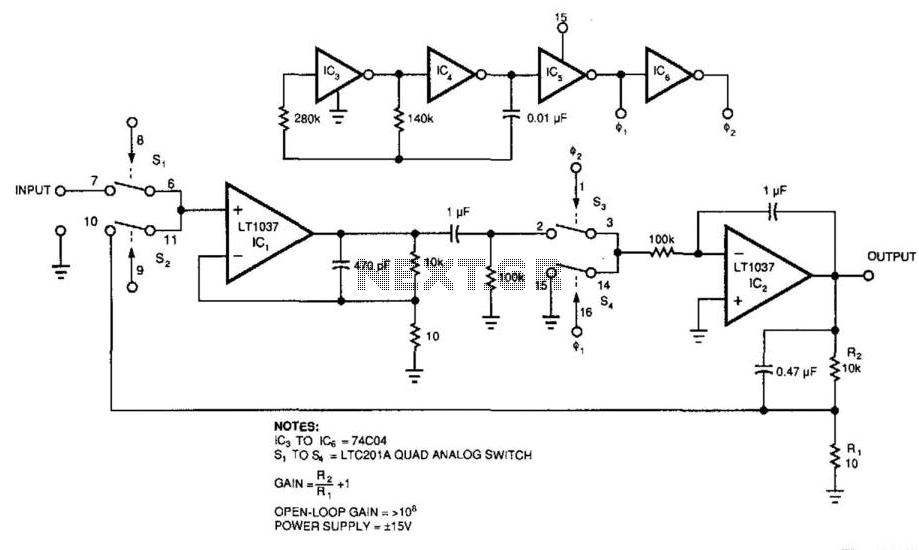
RF amplifier and filter for 10.7 MHz
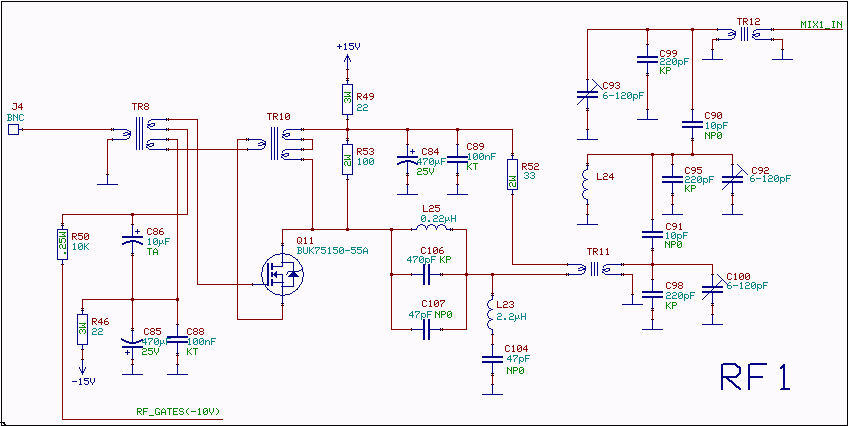
The RF amplifier is similar to the one used in the 2.5 MHz amplifier. At a frequency of 10 MHz, the capacitances of a power MOSFET become significant. Noiseless feedback using transformers is no longer straightforward. Intermodulation and overtones are caused by the variation of the capacitances with voltage. Performance is adequate if a MOSFET with high enough channel resistance is selected, which is associated with small capacitances. The input third-order intercept point (IP3) of the RF amplifier is approximately +45 dBm, which is high enough to make the 10.7 to 2.5 MHz converter dominated by intermodulation distortion (IM3) from the mixer. The entire unit has an input IP3 of about +40 dBm. The gate transformer, TR8, is wound on a ferrite toroid core from Ferroxcube (Philips), material 4C65, type TN 14/9/5. The gate winding consists of 6 turns, the source winding has 3 turns, and the input winding has 7 turns. The wire dimension is uncritical. The drain transformer, TR10, is also wound on a ferrite toroid core from Ferroxcube (Philips), material 4C65, type TN 14/9/5, with a winding of 6 turns using three twisted wires, and the wire dimension is uncritical. The 10.7 MHz bandpass filter has a flat response over approximately 500 kHz. The frequency response is shown in figures 2 and 3. The primary purpose of the 10.7 MHz filter is to suppress the mirror image at 2.5 MHz above the local oscillator. Since the mixer is sensitive to harmonics of the local oscillator, higher frequencies must also be well suppressed. The mirror frequency (15.7 MHz) is suppressed by more than 80 dB. A notch filter at this frequency ensures that without the notch, the mirror frequency would only be attenuated by about 65 dB. The notch is constructed using low-cost standard inductors, which form resonators at 15 MHz, thus avoiding third-order intermodulation problems for strong signals at 10.7 MHz. The 10.7 MHz receiver is intended as an intermediate frequency (IF) unit. The unit preceding it is responsible for suppressing signals at undesired responses of the 10.7 MHz unit. Undesired responses several MHz away from the desired passband will be easily suppressed by an additional 40 dB, providing a mirror image rejection in excess of 120 dB. Feeding very strong signals at 13.2 and 15.7 MHz simultaneously to the unit may generate third-order intermodulation products within the desired passband due to the non-linearities of the 2.2 microhenry inductor in the notch filter. This necessitates that stages in front of the 10.7 MHz unit suppress 15 MHz by at least 40 dB. The 10.7 MHz bandpass filter utilizes T80-6 toroid cores from Amidon, with the resonant winding consisting of 12 turns of 0.8 mm enameled wire on all three cores, TR11, L24, and TR12. The input winding on TR11 and the output winding on TR12 consist of 4 turns of 0.5 mm wire.
The RF amplifier circuit operates at a frequency of 10 MHz, where the characteristics of the power MOSFETs play a critical role in performance. As the frequency increases, the capacitance of the MOSFETs becomes significant, leading to challenges in achieving noiseless feedback through transformer coupling. This effect can introduce intermodulation distortion and harmonic overtones due to capacitance variations with voltage, which necessitates careful selection of MOSFETs with high channel resistance and low capacitance.
The input IP3 of +45 dBm indicates that the amplifier can handle strong input signals without significant distortion, making it suitable for use in RF applications. The design includes two transformers, TR8 and TR10, which are essential for signal coupling. Both transformers are constructed from the same ferrite core material, ensuring consistent performance characteristics. The winding configurations are designed to optimize the coupling and minimize losses, with the gate transformer having a specific turn ratio to match the impedance of the MOSFET gate.
The inclusion of a 10.7 MHz bandpass filter is critical for rejecting unwanted signals, particularly harmonics and mirror frequencies that could interfere with the desired signal. The filter is designed to maintain a flat frequency response over a bandwidth of approximately 500 kHz, effectively suppressing the mirror frequency of 15.7 MHz by more than 80 dB. The notch filter at this frequency is particularly important as it prevents the introduction of intermodulation products that could arise from strong signals.
Overall, the RF amplifier circuit is designed to provide robust performance in a challenging RF environment, with considerations made for intermodulation distortion, frequency response, and signal integrity. The use of carefully selected components and transformer design ensures that the amplifier meets the stringent requirements of RF applications.The RF amplifier is similar to the one used in the 2. 5MHz amplifier. At a frequency of 10MHz the capacitances of a power MOS-FET become significant. Noiseless feedback by the use of transformers is no longer straightforward. Intermodulation and overtones are caused by the variation of the capacitances with the voltage. Performance is adequate if a MOS-FET with high enough channel resistance is selected (with associated small capacitances). The input IP3 of the RF amplifier is in the order of +45dBm which is high enough to make the 10. 7 to 2. 5MHz converter dominated by IM3 from the mixer. The entire unit has an input IP3 of about +40dBm. The gate transformer, TR8, is wound on a ferrite toroid core from Ferroxcube (Philips). Material 4C65, type TN 14/9/5. The gate winding is 6 turns, the source winding is 3 turns and the input winding is 7 turns. The wire dimension is uncritical. The drain transformer, TR10, is wound on a ferrite toroid core from Ferroxcube (Philips). Material 4C65, type TN 14/9/5. The winding is 6 turns with three twisted wires. The wire dimension is uncritical. The 10. 7MHz band pass filter has a flat response over about 500 kHz. The frequency response is shown in figures 2 and 3. The main purpose of the 10. 7MHz filter is to suppress the mirror image 2. 5 MHz above the local oscillator. Since the mixer is sensitive at harmonics of the local oscillator, higher frequencies also have to be well suppressed. The mirror frequency (15. 7MHz) is suppressed by more than 80dB. There is a notch filter at this frequency, without the notch the mirror frequency would have been attenuated only by about 65dB.
The notch is made with low cost standard inductors. They form resonators at 15MHz so they do not produce third order intermodulation problems for strong signals at 10. 7MHz. The 10. 7MHz receiver is intended as an IF unit. The unit in front of it is responsible for suppressing signals at the undesired responses of the 10. 7MHz unit. Undesired responses several MHz away from the desired passband will easily be suppressed by an additional 40dB to provide a mirror image rejection in excess of 120dB.
Feeding very strong signals at 13. 2 and 15. 7 simultaneously to the unit may give third order intermodulation products within the desired passband due to the non-linearities of the 2. 2 microhenry inductor in the notch filter. This is another reason why stages in front of the 10. 7 MHz unit should suppress 15MHz by at least 40dB. The 10. 7 MHz bandpass filter uses T80-6 toroid cores from Amidon. The resonant winding is 12 turns of 0. 8 mm enameld wire on all three cores, TR11, L24 and TR12. The input winding on TR11 as well as the output winding on TR12 is 4 turns of 0. 5 mm wire. 🔗 External reference
The RF amplifier circuit operates at a frequency of 10 MHz, where the characteristics of the power MOSFETs play a critical role in performance. As the frequency increases, the capacitance of the MOSFETs becomes significant, leading to challenges in achieving noiseless feedback through transformer coupling. This effect can introduce intermodulation distortion and harmonic overtones due to capacitance variations with voltage, which necessitates careful selection of MOSFETs with high channel resistance and low capacitance.
The input IP3 of +45 dBm indicates that the amplifier can handle strong input signals without significant distortion, making it suitable for use in RF applications. The design includes two transformers, TR8 and TR10, which are essential for signal coupling. Both transformers are constructed from the same ferrite core material, ensuring consistent performance characteristics. The winding configurations are designed to optimize the coupling and minimize losses, with the gate transformer having a specific turn ratio to match the impedance of the MOSFET gate.
The inclusion of a 10.7 MHz bandpass filter is critical for rejecting unwanted signals, particularly harmonics and mirror frequencies that could interfere with the desired signal. The filter is designed to maintain a flat frequency response over a bandwidth of approximately 500 kHz, effectively suppressing the mirror frequency of 15.7 MHz by more than 80 dB. The notch filter at this frequency is particularly important as it prevents the introduction of intermodulation products that could arise from strong signals.
Overall, the RF amplifier circuit is designed to provide robust performance in a challenging RF environment, with considerations made for intermodulation distortion, frequency response, and signal integrity. The use of carefully selected components and transformer design ensures that the amplifier meets the stringent requirements of RF applications.The RF amplifier is similar to the one used in the 2. 5MHz amplifier. At a frequency of 10MHz the capacitances of a power MOS-FET become significant. Noiseless feedback by the use of transformers is no longer straightforward. Intermodulation and overtones are caused by the variation of the capacitances with the voltage. Performance is adequate if a MOS-FET with high enough channel resistance is selected (with associated small capacitances). The input IP3 of the RF amplifier is in the order of +45dBm which is high enough to make the 10. 7 to 2. 5MHz converter dominated by IM3 from the mixer. The entire unit has an input IP3 of about +40dBm. The gate transformer, TR8, is wound on a ferrite toroid core from Ferroxcube (Philips). Material 4C65, type TN 14/9/5. The gate winding is 6 turns, the source winding is 3 turns and the input winding is 7 turns. The wire dimension is uncritical. The drain transformer, TR10, is wound on a ferrite toroid core from Ferroxcube (Philips). Material 4C65, type TN 14/9/5. The winding is 6 turns with three twisted wires. The wire dimension is uncritical. The 10. 7MHz band pass filter has a flat response over about 500 kHz. The frequency response is shown in figures 2 and 3. The main purpose of the 10. 7MHz filter is to suppress the mirror image 2. 5 MHz above the local oscillator. Since the mixer is sensitive at harmonics of the local oscillator, higher frequencies also have to be well suppressed. The mirror frequency (15. 7MHz) is suppressed by more than 80dB. There is a notch filter at this frequency, without the notch the mirror frequency would have been attenuated only by about 65dB.
The notch is made with low cost standard inductors. They form resonators at 15MHz so they do not produce third order intermodulation problems for strong signals at 10. 7MHz. The 10. 7MHz receiver is intended as an IF unit. The unit in front of it is responsible for suppressing signals at the undesired responses of the 10. 7MHz unit. Undesired responses several MHz away from the desired passband will easily be suppressed by an additional 40dB to provide a mirror image rejection in excess of 120dB.
Feeding very strong signals at 13. 2 and 15. 7 simultaneously to the unit may give third order intermodulation products within the desired passband due to the non-linearities of the 2. 2 microhenry inductor in the notch filter. This is another reason why stages in front of the 10. 7 MHz unit should suppress 15MHz by at least 40dB. The 10. 7 MHz bandpass filter uses T80-6 toroid cores from Amidon. The resonant winding is 12 turns of 0. 8 mm enameld wire on all three cores, TR11, L24 and TR12. The input winding on TR11 as well as the output winding on TR12 is 4 turns of 0. 5 mm wire. 🔗 External reference
